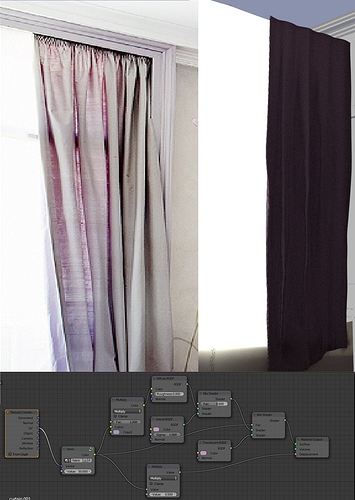@MC78: Just to be clear, I’m not talking about using fresnel/facing to change between two shaders in a mix shader, I’m talking about feeding the fresnel/facing directly into roughness/anisotropy values shaping their response via curves. See screenshot. Is this something along the lines you want? I use curves because they’re easier to “see” in a screenshot, but I’m guessing a regular ramp would be more efficient. The example shows reflection near 90° perp to the ground to be much sharper and less anisotropic than those closer to grazing angles.
@ CarlG… thanks for the updated links… all working well… Great Job!
Anyone have any thoughts on foil, like aluminum foil? Not so much the shininess, but rather the varied wrinkles. I’ve tried layering different noises, voronoi, etc, but nothing very satisfactory.
actually im looking for a good metallic cloth material myself (to be used in ballet costumes)
couple side notes
1 does anybody know where you can do a direct download of a good library of documented materials??
2 is there a way to Boolean mix texture files (and/nand or/nor ect)??
Maybe something like this?
Texture file here (4K PNG, 5.4 MB)
So, this is obviously no procedural solution, as I found the available texture types in Blender a bit lacking for this kind of material - or maybe I’m just too impatient to fiddle with the parameters long enough… Texture was created outside of Blender in another app.
Chocolate easter bunny!
(I know that the bump texture stretches here and there: that’s me being lazy with my UVs again…)
@IkariShinji
You only need one Bump Node… use Color Mix nodes behind it to mix the texture maps together… might work better…
Better… in what regard? I find it more intuitive this way, with individual strength and distance controls for each map/bump layer. But to each his own…![]()
Plugging the Fresnel directly into the roughness gives nice results:
Here’s the node setup:
For foil, two Musgraves set to ridged multifractal (with different settings with one large scale and one small scale) added to each other, and then a Voronoi intensity factor output added on top of that put into displacement seems to get fairly close if trying to keep it procedural.
@SolarLiner nice work on the Fresnel into the Roughness… that works great!
@pauljs75_ nice work on the Foil…
Better… in what regard? I find it more intuitive this way, with individual strength and distance controls for each map/bump layer. But to each his own…
I was told that stacking too many Bump Maps messes up the color matrix and causes a bunch of problems at render time… perhaps the person who told me that didn’t know what they were saying… looks like your doing it just fine…
That might be worth investigating. It’s not that I know exactly what I do concerning nodes - just fooling around with what I see fit…![]()
Hi folks,
This thread has inspired me to play with procedural materials more and one of the projects I started was coming up with a shader for wooden planking. Here is what I have so far:
What is immediately obvious to me that wooden planks are just a bunch of long strips of wood with the seams going off into infinity. If you look at the (fake) hardwood floors at my house no two planks seems to be the same length and the end seams are offset from the row on either side.
What strategy would you guys take to get that effect?
Here is my node setup:
f you look at the (fake) hardwood floors at my house no two planks seems to be the same length and the end seams are offset from the row on either side.
I’m wondering if there is not a way to do that using the Brick Proceedural…
if there was some way to randomly knock out some of the mortar lines you would end up with some thing like what your talking about…
It might be something that one ends up having to write one’s own shader for…
which I currenlty haven’t started messing with yet… (heck I’m still learning cycles texturing)
Ya know… I keep reading the API docs and every time I do my head spins. Besides which I’m not a python person, but this may give me the final push to get there…
the API is not a tutorial
more a formal description for programmer
so it is a pain in the neck to learn things!
better ask examples in python forum
I did a few nodes set up for cycles
and not easy how to do it
happy bl
I keep reading the API docs and every time I do my head spins
Yes… me too… that’s one reason I have been putting it off… (well that and work… and spending time modeling and Rigging… and trying to learn how to texture properly in blender… etc… etc… ) LOL!:spin::yes::eek:
yep… I’ve worked with API docs before. They don’t make things easy. I guess part of my hangup is the terminology used. I’ve always said that a good programmer can knock something out in any language… just a matter of learning new syntax.
Another issue with the Blender API as with any very flexible API is the more flexible you make one the more complex it is to use.
hi
definitely some interesting setups here, i tried to do a realistic curtain material but i struggled, i tweaked a lot but didn’t something good, here is my result, setup is at the end:
as you can see on the left is what i try to imitate, any help would be appreciated:
try adding another mix node to the right of the one’s you have there now … plug in a transparency shader to it to see if that doesn’t get some light coming through it…






